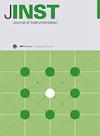新型SPES束流冷却器的实现与仿真
IF 1.3
4区 工程技术
Q3 INSTRUMENTS & INSTRUMENTATION
引用次数: 0
摘要
新项目“选择性生产外来物种”(SPES)的目标之一是生产和选择新的中子同位素[1,2,3,4]。生产这些物种所采用的技术是同位素在线选择(ISOL),该技术使用高分辨率质谱仪(HRMS)延迟了光束生产后同位素的分离。为了实现同位素的良好分离,束流的横向发射度和能量扩散应该具有非常低的值,因此束流冷却器(BC)位于ISOL目标(即束流源)和HRMS之间。在期望使用重同位素(质量数>100)的SPES项目中,光谱仪分辨率必须最好高于dm/m = 5 × 10 -5,因此HRMS入口的光束特征应至少为ε n 95% <8.3 × 10 -3 π mm mrad和σ E <1.5 eV。BC器件致力于改善光束在发射度和能量扩散方面的特性。法国卡昂的体质实验室(LPC)为意大利帕多瓦附近的Legnaro国家实验室(LNL)的spe设施设计并实现了一个新的BC。由于一个耗散过程,BCs使光束冷却,在这个过程中,热能从光束离子传递到另一种介质,这种介质的成分通常要轻得多,在我们的例子中是氦气。这个过程发生在一个约束系统内,一方面限制冷却介质的扩散,另一方面允许光束沿着所需的轨迹继续,在这个装置中,它是一排射频四极杆,在一个几乎封闭的腔室中。本文档中描述的BC的一些规格:RFQ长723mm,内部半径5mm;RFQ包括在730 mm×280 mm×220毫米的毒气室中。在它之前是由一根接地管(长388毫米)和三个聚焦电极沿光束轨迹组成的注射部分。在另一侧有带两个聚焦电极的提取部分。本文介绍了新型BC的主要特点,并给出了模拟梁动力的初步研究结果。该分析还包括对BC内外气体分布的调查。光束动态模拟基于Simion代码[5],气体分布估计使用MolFlow+计算[6]。仿真结果表明,精确设置BC可以大大提高发射度,但能量扩散仍有待改善。在加速区限制气体压力似乎允许所需的最终推进。本文章由计算机程序翻译,如有差异,请以英文原文为准。
Realization and simulations of the new SPES Beam Cooler
Abstract One of the aim of the new project Selective Production of Exotic Species (SPES) is to produce and select new, neutron reach, isotopes [1,2,3,4]. The technique adopted to produce these species is the Isotope Selection On Line (ISOL) that postpones the separation of the isotopes after the beam production, using a High-Resolution Mass Spectrometer (HRMS). In order to allow a good separation of isotopes , the transverse emittance and the energy spread of the beam should have very low values, for this reason the Beam Cooler (BC) is located between the ISOL target, i.e. the beam source, and the HRMS. In the SPES project, where heavy isotopes are expected (mass number >100), the spectrometer resolution must be preferably higher than dm/m = 5 × 10 -5 and thus the features of the beam at the entrance of the HRMS should be at least ε n 95% < 8.3 × 10 -3 π mm mrad and σ E < 1.5 eV. BC devices are devoted to improve the beam features in terms of emittance and energy spread. A new BC has been designed and realized by the Laboratoire de Physique Corpuscolaire (LPC) at Caen, France, for the SPES facility at Laboratori Nazionali di Legnaro (LNL), near Padova, Italy. BCs cool down the beam thanks to a dissipative process in which the thermal energy passes from the beam ions to another medium whose constituent is typically much lighter, Helium gas in our case. This process takes place inside a confinement system that on the one hand to limit the spread of the cooling medium, and on the other to allow the beam to continue along the required trajectory, in the presented device it is a row of radio frequency quadrupoles in an almost closed chamber. Some specifications of the BC described in this document: the RFQ is 723 mm long, its internal radius is 5 mm; the RFQ is included in the gas chamber which is 730 mm×280 mm×220 mm. Before it there is the injection part composed by, following the beam trajectory, a grounded pipe (388 mm long) and three focusing electrodes. On the opposite side there is the extraction part with two focusing electrodes. This document presents the main features of the new BC together with the results of a preliminary study where the beam dynamic has been simulated. The analysis embeds also the investigation of the gas distribution inside and outside the BC. The beam dynamic simulations are based on the Simion code [5] while the estimation of the gas distribution is computed with MolFlow+ [6]. Simulations show that accurately setting the BC leads to a large improvement of the emittance while the energy spread still needs to be improved. Limiting the gas pressure in the acceleration zone seems to allow the required final boost.
求助全文
通过发布文献求助,成功后即可免费获取论文全文。
去求助
来源期刊

Journal of Instrumentation
工程技术-仪器仪表
CiteScore
2.40
自引率
15.40%
发文量
827
审稿时长
7.5 months
期刊介绍:
Journal of Instrumentation (JINST) covers major areas related to concepts and instrumentation in detector physics, accelerator science and associated experimental methods and techniques, theory, modelling and simulations. The main subject areas include.
-Accelerators: concepts, modelling, simulations and sources-
Instrumentation and hardware for accelerators: particles, synchrotron radiation, neutrons-
Detector physics: concepts, processes, methods, modelling and simulations-
Detectors, apparatus and methods for particle, astroparticle, nuclear, atomic, and molecular physics-
Instrumentation and methods for plasma research-
Methods and apparatus for astronomy and astrophysics-
Detectors, methods and apparatus for biomedical applications, life sciences and material research-
Instrumentation and techniques for medical imaging, diagnostics and therapy-
Instrumentation and techniques for dosimetry, monitoring and radiation damage-
Detectors, instrumentation and methods for non-destructive tests (NDT)-
Detector readout concepts, electronics and data acquisition methods-
Algorithms, software and data reduction methods-
Materials and associated technologies, etc.-
Engineering and technical issues.
JINST also includes a section dedicated to technical reports and instrumentation theses.
 求助内容:
求助内容: 应助结果提醒方式:
应助结果提醒方式:


